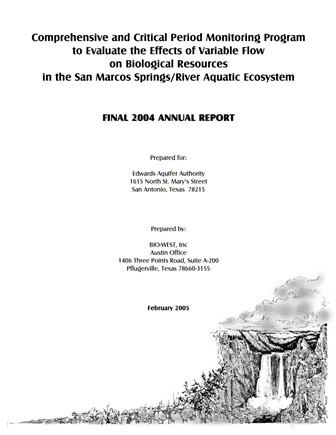Comprehensive and Critical Period Monitoring Program to Evaluate the Effects of Variable Flow on Biological Resources in the San Marcos Springs/River Aquatic Ecosystem Final 2004 Annual Report

| Summary |
|
The purpose of this report is to document the results of all aquatic ecosystem monitoring conducted in 2004 at San Marcos Springs located in San Marcos, Texas. The monitoring and report preparation was performed by BIO-WEST, Inc. Pflugerville, Texas. [Excerpted from the Executive Summary] Flooding resulted in a temporary reduction in total aquatic vegetation coverage in all reaches, but affected the IH-35 Reach most dramatically and the City Park Reach the least. However, many plant types quickly responded to the scouring flows with rapid re-growth and expanded to a total coverage that exceeded the pre-flooding condition. The plant type that was most susceptible to scour during flooding in the San Marcos Springs/River ecosystem was Cabomba, which occurs in areas of deep silt. It was also the highest quality habitat type (of those sampled quantitatively) for fountain darters in the San Marcos Springs/River ecosystem. … There was a substantial increase in total coverage of Texas wild-rice throughout the San Marcos River in 2000-2004. … There are fewer abundant vegetation types in the San Marcos Springs/River ecosystem than in the Comal Springs/River ecosystem and the densities of fountain darters observed in the various vegetation types did not range as widely…. The results show a relatively consistent estimate of the fountain darter population during 2000-2004 with some decrease associated with each high-flow event…. These results revealed that discharge has had limited influence on fountain darter densities with the discharge that has occurred in 2000-2004. However, the limited data from low-flow conditions did not allow an extensive statistical assessment of fountain darter population dynamics…. In general, the number of fountain darters per net in the San Marcos River was much lower than in the Comal River. … In addition to evaluating fountain darter population dynamics, the entire fish community was assessed by calculating species diversity in each sample reach during each sample effort in 2000-2004. There was no difference in diversity between the two reaches and no discernable patterns of change in diversity at the reach level during 2000-2004. One additional area of concern to fountain darters, the density of giant ramshorn snails (Marisa cornuarietis) was monitored in 2000-2004. By all indications the densities of giant ramshorn snails observed in the San Marcos Springs/River ecosystem during the study period to pose no serious threat to the aquatic vegetative community (i.e., fountain darter habitat). However, because of the impact that this exotic species can have under heavier densities, close monitoring of this species should continue. The gill parasite that has been reported to infect the fountain darter in the Comal Springs/River ecosystem was not visually evident in fountain darters collected from the San Marcos Springs/River ecosystem during 2000-2004. … Observations of the San Marcos salamander have varied in number within and between locations during 2000-2004, but individuals have been observed in each sample location during each sample period. Filamentous algae was abundant in most sampling events conducted during 2000-2004 in the sample site adjacent to the former Aquarena Springs Hotel and the deep site in Spring Lake and required clearing the algae prior to sampling efforts. This may have impacted sampling efficiency. Regardless, the Hotel site consistently had the highest number of San Marcos salamanders. … More data from low-flow periods (particularly from an extended low-flow period) are essential to fully evaluate the biological risks associated with future critical periods (high or low flow). This study remains the most comprehensive biological evaluation that has ever been conducted on the San Marcos Springs/River ecosystem. |
Search for Documents
Advance Search
Explore EAA's Scientific Reports
- All Reports
- Remote Sensing
- Precipitation
- Overview Studies
- Modeling
- Hydrology and Hydrogeology
- History
- Groundwater Recharge, Recharge Zone
- Groundwater Movement
- Geomorphology and Caves
- Weather Modification
- Geology
- Water Use and Conservation
- Geochemistry
- Water Resources Planning and Management
- Floods and Drought
- Water Quality
- Climatology
- Surface Water / Groundwater Relationship
- Biology
- Springs, Groundwater Discharge
- Archaeology
- RZ Protection
- Aquifer Levels
